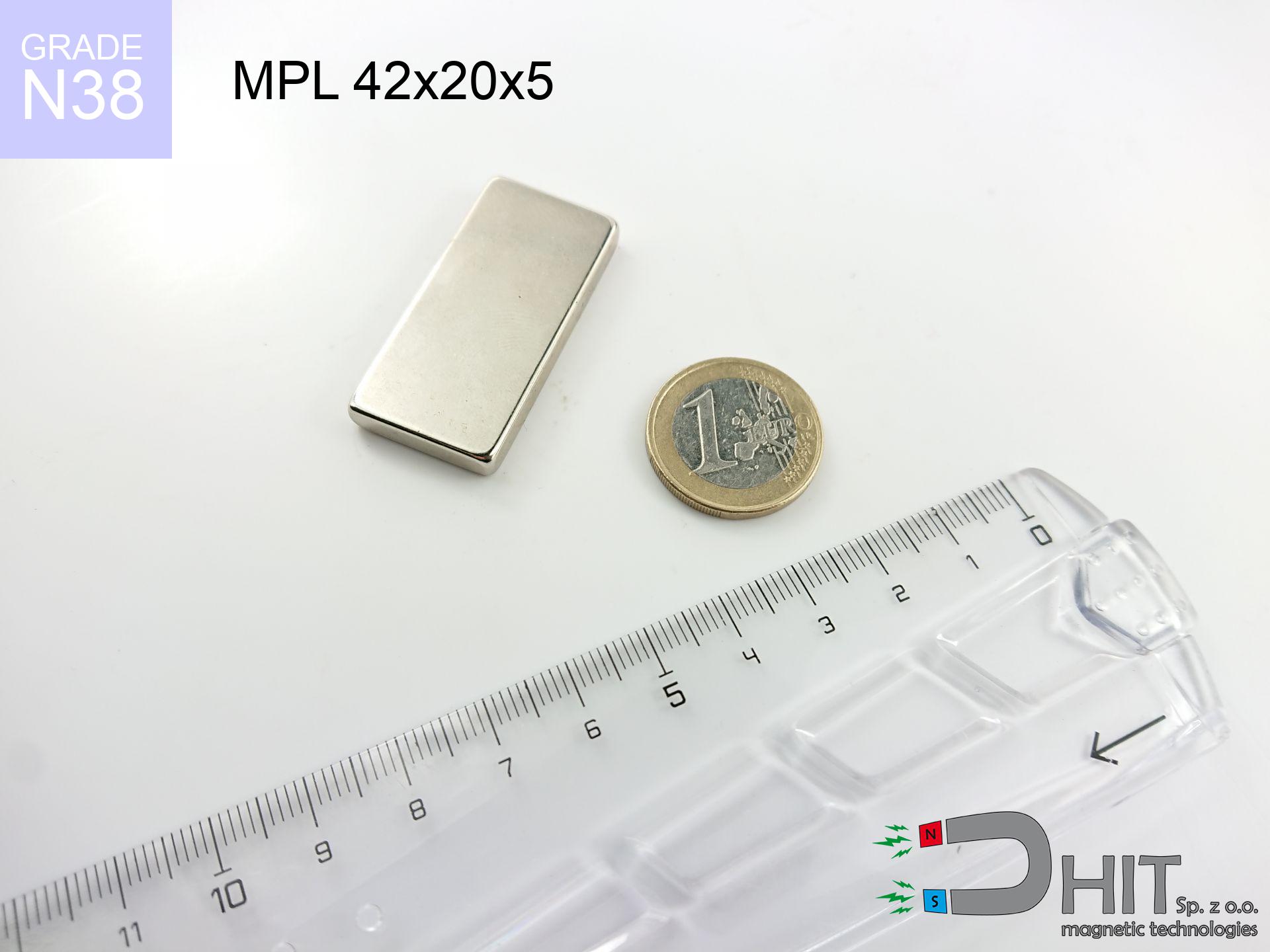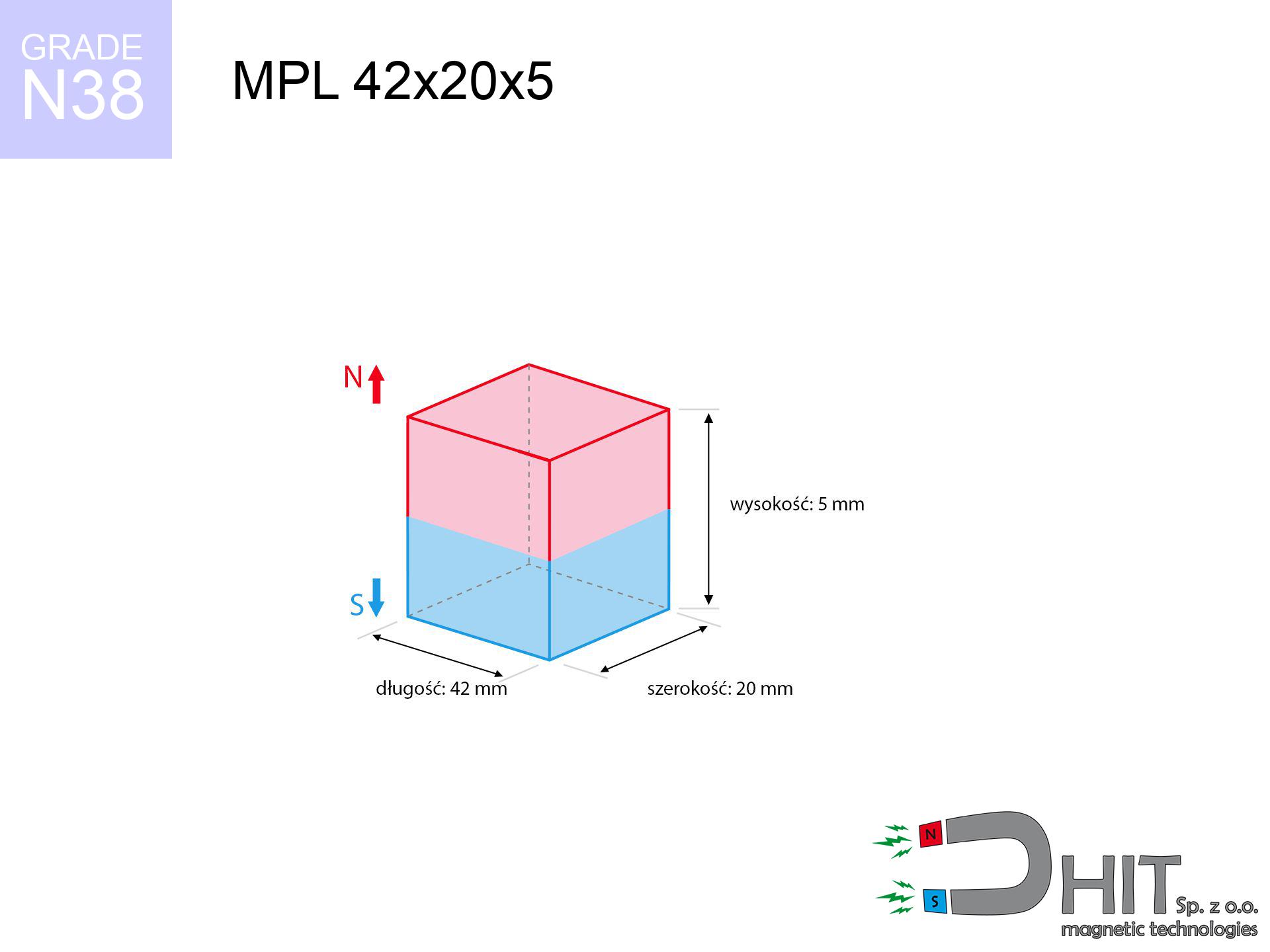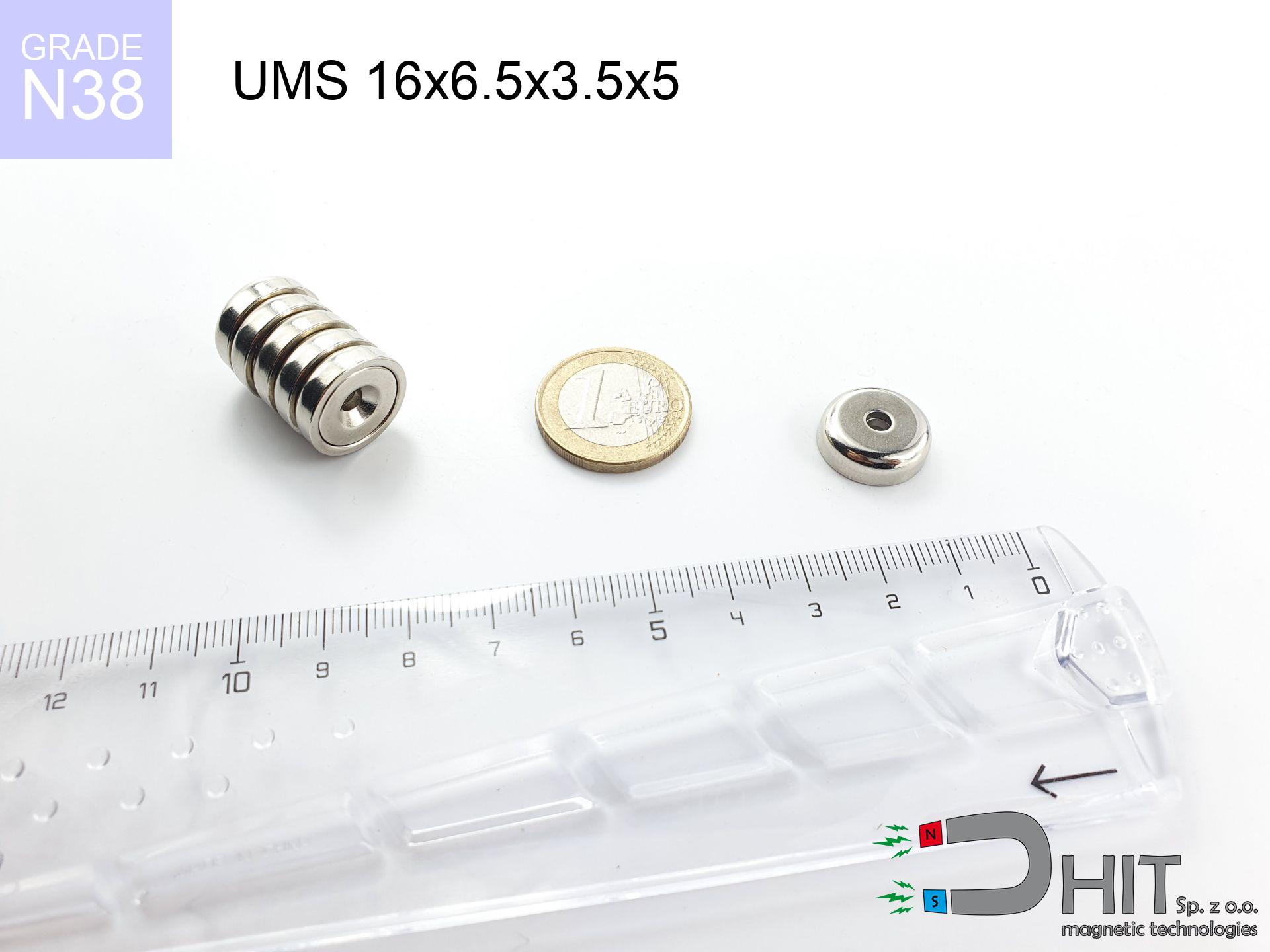MPL 42x20x5 / N38 - lamellar magnet
lamellar magnet
Catalog no 020163
GTIN: 5906301811695
length [±0,1 mm]
42 mm
Width [±0,1 mm]
20 mm
Height [±0,1 mm]
5 mm
Weight
31.5 g
Magnetization Direction
↑ axial
Load capacity
11.44 kg / 112.19 N
Magnetic Induction
203.37 mT
Coating
[NiCuNi] nickel
15.62 ZŁ with VAT / pcs + price for transport
12.70 ZŁ net + 23% VAT / pcs
12.59 ZŁ net was the lowest price in the last 30 days
bulk discounts:
Need more?Can't decide what to choose?
Contact us by phone
+48 888 99 98 98
otherwise send us a note by means of
form
through our site.
Lifting power as well as shape of a magnet can be verified with our
magnetic mass calculator.
Same-day shipping for orders placed before 14:00.
MPL 42x20x5 / N38 - lamellar magnet
Magnetic properties of material N38
Physical properties of NdFeB
Shopping tips
Thanks to their mighty power, flat magnets are commonly used in products that need exceptional adhesion.
The standard temperature resistance of these magnets is 80 °C, but with larger dimensions, this value can increase.
Moreover, flat magnets usually have different coatings applied to their surfaces, such as nickel, gold, or chrome, to improve their corrosion resistance.
The magnet named MPL 42x20x5 / N38 i.e. a lifting capacity of 11.44 kg which weighs a mere 31.5 grams, making it the ideal choice for projects needing a flat magnet.
Contact surface: Due to their flat shape, flat magnets guarantee a greater contact surface with other components, which is beneficial in applications needing a stronger magnetic connection.
Technology applications: These magnets are often utilized in various devices, e.g. sensors, stepper motors, or speakers, where the thin and wide shape is crucial for their operation.
Mounting: The flat form's flat shape makes mounting, particularly when it is required to attach the magnet to some surface.
Design flexibility: The flat shape of the magnets permits designers greater flexibility in arranging them in structures, which is more difficult with magnets of other shapes.
Stability: In certain applications, the flat base of the flat magnet can offer better stability, minimizing the risk of sliding or rotating. However, one should remember that the optimal shape of the magnet is dependent on the specific application and requirements. In some cases, other shapes, like cylindrical or spherical, are more appropriate.
Magnets have two poles: north (N) and south (S), which interact with each other when they are oppositely oriented. Poles of the same kind, such as two north poles, act repelling on each other.
Due to these properties, magnets are commonly used in electrical devices, such as motors, speakers, sensors, or magnetic locks. Neodymium magnets stand out with the highest power of attraction, making them indispensable for applications requiring strong magnetic fields. Moreover, the strength of a magnet depends on its size and the materials used.
It should be noted that high temperatures can weaken the magnet's effect. Every magnetic material has its Curie point, meaning that once this temperature is exceeded, the magnet stops being magnetic. Interestingly, strong magnets can interfere with the operation of devices, such as compasses, credit cards or electronic devices sensitive to magnetic fields. Therefore, it is important to exercise caution when using magnets.
Advantages as well as disadvantages of neodymium magnets NdFeB.
In addition to their immense field intensity, neodymium magnets offer the following advantages:
- Their magnetic field is maintained, and after around ten years, it drops only by ~1% (theoretically),
- They are highly resistant to demagnetization caused by external magnetic fields,
- Thanks to the shiny finish and gold coating, they have an visually attractive appearance,
- They possess significant magnetic force measurable at the magnet’s surface,
- They are suitable for high-temperature applications, operating effectively at 230°C+ due to advanced heat resistance and form-specific properties,
- With the option for tailored forming and personalized design, these magnets can be produced in various shapes and sizes, greatly improving application potential,
- Key role in new technology industries – they are utilized in HDDs, electric motors, healthcare devices or even sophisticated instruments,
- Thanks to their efficiency per volume, small magnets offer high magnetic performance, in miniature format,
Disadvantages of rare earth magnets:
- They are prone to breaking when subjected to a powerful impact. If the magnets are exposed to shocks, they should be placed in a protective enclosure. The steel housing, in the form of a holder, protects the magnet from breakage and increases its overall robustness,
- High temperatures may significantly reduce the field efficiency of neodymium magnets. Typically, above 80°C, they experience permanent loss in performance (depending on height). To prevent this, we offer heat-resistant magnets marked [AH], capable of working up to 230°C, which makes them perfect for high-temperature use,
- They rust in a wet environment. If exposed to rain, we recommend using sealed magnets, such as those made of rubber,
- The use of a protective casing or external holder is recommended, since machining multi-axis shapes in neodymium magnets is not feasible,
- Possible threat due to small fragments may arise, if ingested accidentally, which is crucial in the context of child safety. Additionally, tiny components from these products have the potential to interfere with diagnostics once in the system,
- Higher purchase price is an important factor to consider compared to ceramic magnets, especially in budget-sensitive applications
Highest magnetic holding force – what contributes to it?
The given holding capacity of the magnet represents the highest holding force, measured in ideal conditions, specifically:
- with mild steel, serving as a magnetic flux conductor
- of a thickness of at least 10 mm
- with a smooth surface
- with zero air gap
- in a perpendicular direction of force
- at room temperature
Lifting capacity in real conditions – factors
Practical lifting force is dependent on factors, by priority:
- Air gap between the magnet and the plate, as even a very small distance (e.g. 0.5 mm) causes a drop in lifting force of up to 50%.
- Direction of applied force, because the maximum lifting capacity is achieved under perpendicular application. The force required to slide the magnet along the plate is usually several times lower.
- Thickness of the plate, as a plate that is too thin causes part of the magnetic flux not to be used and to remain wasted in the air.
- Material of the plate, because higher carbon content lowers holding force, while higher iron content increases it. The best choice is steel with high magnetic permeability and high saturation induction.
- Surface of the plate, because the more smooth and polished it is, the better the contact and consequently the greater the magnetic saturation.
- Operating temperature, since all permanent magnets have a negative temperature coefficient. This means that at high temperatures they are weaker, while at sub-zero temperatures they become slightly stronger.
* Holding force was measured on a smooth steel plate of 20 mm thickness, when the force acted perpendicularly, in contrast under parallel forces the lifting capacity is smaller. Additionally, even a small distance {between} the magnet’s surface and the plate decreases the load capacity.
We Recommend Caution with Neodymium Magnets
Neodymium magnets can demagnetize at high temperatures.
Even though magnets have been observed to maintain their efficacy up to temperatures of 80°C or 175°F, it's essential to consider that this threshold may fluctuate depending on the magnet's type, configuration, and intended usage.
Neodymium magnets can attract to each other, pinch the skin, and cause significant swellings.
In the case of placing a finger in the path of a neodymium magnet, in such a case, a cut or a fracture may occur.
Keep neodymium magnets away from people with pacemakers.
Neodymium magnets generate strong magnetic fields. As a result, they interfere with the operation of a pacemaker. This happens because such devices have a function to deactivate them in a magnetic field.
Under no circumstances should neodymium magnets be placed near a computer HDD, TV, and wallet.
Strong fields generated by neodymium magnets can damage magnetic storage media such as floppy disks, credit cards, magnetic ID cards, cassette tapes, video tapes, or other similar devices. In addition, they can damage televisions, VCRs, computer monitors, and CRT displays. You should especially avoid placing neodymium magnets near electronic devices.
The magnet coating contains nickel, so be cautious if you have a nickel allergy.
Studies show a small percentage of people have allergies to certain metals, including nickel. An allergic reaction often manifests as skin redness and rash. If you have a nickel allergy, you can try wearing gloves or simply avoid direct contact with nickel-plated neodymium magnets.
Neodymium magnetic are incredibly fragile, they easily break as well as can crumble.
Neodymium magnets are delicate and will break if allowed to collide with each other, even from a distance of a few centimeters. They are coated with a shiny nickel plating similar to steel, but they are not as hard. At the moment of collision between the magnets, tiny sharp metal pieces can be propelled in various directions at high speed. Eye protection is recommended.
Neodymium magnets are the most powerful magnets ever invented. Their strength can surprise you.
Read the information on our website on how to properly utilize neodymium magnets and avoid significant harm to your body and unintentional damage to the magnets.
Magnets should not be treated as toys. Therefore, it is not recommended for youngest children to have access to them.
Neodymium magnets are not toys. Do not allow children to play with them. In the case of swallowing multiple magnets simultaneously, they can attract to each other through the intestinal walls. In the worst case scenario, this can lead to death.
Never bring neodymium magnets close to a phone and GPS.
Neodymium magnets produce intense magnetic fields that interfere with magnetometers and compasses used in navigation, as well as internal compasses of smartphones and GPS devices.
Dust and powder from neodymium magnets are highly flammable.
Avoid drilling or mechanical processing of neodymium magnets. If the magnet is crushed into fine powder or dust, it becomes highly flammable.
Pay attention!
Please see the article - What danger lies in neodymium magnets? You will learn how to handle them properly.





![UMP 75x25 [M10x3] GW F200 PLATINIUM / N52 - search holder UMP 75x25 [M10x3] GW F200 PLATINIUM / N52 - search holder](https://cdn3.dhit.pl/graphics/products/ump-75x25-m10x3-gw-f200-platinium-tav.jpg)
![SM 32x150 [2xM8] / N52 - magnetic separator SM 32x150 [2xM8] / N52 - magnetic separator](https://cdn3.dhit.pl/graphics/products/sm-32x150-2xm8-xuc.jpg)


